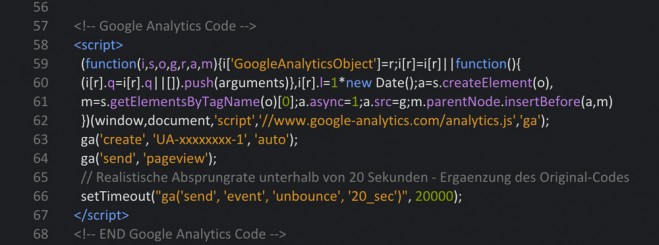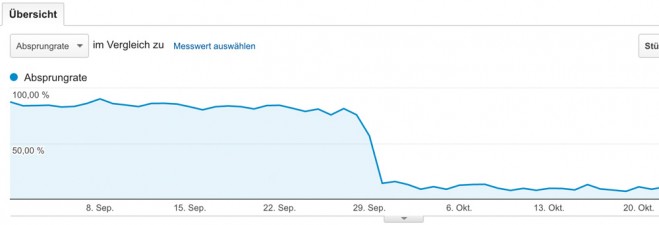Google Analytics: How to Avoid High Bounce Rates
If you own a website and use Google Analytics to keep track of visitors, you will quickly notice that the infamous bounce rate can shoot up pretty high. Bounce rates of over 60 percent are not a rare sight. High bounce rates are not always a bad thing. That’s why we’ll take a close look at what the bounce rate actually is, how it is formed, and how you can achieve a realistic bounce rate.
Exact Definition: This is the Bounce Rate
The bounce rate displays the percentage of visitors that leave your website after just one pageview without accessing any further pages of the site Google defines the bounce rate as follows:
The bounce rate is the percentage of visits on a single page (that means sessions, in which the user left your website on the landing page without interaction with the site).
Thus, if you have a bounce rate of 80 percent, that means that 80 percent of your visitors only looked at one single page, and left your website right after that without clicking anywhere else. However, a high bounce rate doesn’t have to be bad. Some types of websites will always have worse bounce rates than others due to their concept.
What Leads to a High Bounce Rates

Google and the Bounce Rate – Explained Comprehensibly.
The bounce rate of news websites is almost always worse than that of others. Many visitors only come to read a single article and then leave. Bloggers, however, shouldn’t know that problem, as in theory, blogs have a much better bounce rate than news magazines as they are more engagement-driven. But there are more, real factors that can create a seemingly poor bounce rate.
- Bad Content: When the user doesn’t find the information he’s looking for, he’ll leave in no time. This will happen fast and constantly, as long as the content stays bad. The only thing that helps when that’s the case is revising the content.
- Long Loading Times: Most visitors will not accept a long loading time of your website. If the content is not visible after two seconds at most, the user will leave the page. On top of that, it will also be harder to find the website using Google search.
- Too Good SEO: Yes, even a (too) good search engine optimization can cause a high bounce rate. When the user instantly finds the information he’s looking for, he won’t click any further pages either.
- Poor Webdesign: When your website’s layout isn’t all that inviting, or even looks sketchy, the visitor will quickly leave the page. An appealing layout is a must for every website.
- Too Many Advertisements: If a website contains too many ads, this can scare away potential visitors. Less is definitely more in this regard!
- Confusing Navigation: If your visitor simply doesn’t find his way around on your website, he’ll leave it quickly as well.

Are High Bounce Rates Affecting the Ranking?
I think we can answer this question with a definitive yes very easily. Google analyzes the bounce rate in-depth, taking into account that a high bounce rate is not always bad. For that reason, the search engine will also take the duration of the visit on the page into consideration. Only then, a coherent picture is created. When a visitor leaves a website after a couple seconds, that’s always bad. However, if he leaves after five or ten minutes, that’s a very good sign. It only means that the visitor found just what he was looking for.
How to Achieve a Realistic Bounce Rate
Google considers every visitor that leaves the website after just one page a bounce. Thus, the bounce rate increases no matter how long the visitor stayed on that one page. He could be a regular reader, who accessed the page via the website’s feed only to read this one article, as he’s already read the others. It is also possible that the visitor came from Twitter. All direct visits to a website are a sign of specific interest. While this is generally a good thing, these users unfortunately also drive up the bounce rate.
I think that the standard way of measuring the bounce rate gives a false impression, and doesn’t display a website’s reality. A real bounce would be somewhere between five and twenty seconds. The bounce rate is supposed to be significant, as it’s a good tool for website optimization. It is supposed to help you find problems. This can only be done when the bounce rate is realistic. That’s why we need to adjust and “tune” it a little.
Using the following tracking code, by simply replacing the existing one, we decide, that only visits below twenty seconds are counted as a bounce.
Clicking the graphics opens the respective Gist at GitHub.
Adjusting the new Google Analytics Code – analytics.js

Adjusting the old ga.js Analytics Code

The Effects of the New Code
After a short time, we’ll have a more realistic bounce rate at hand. Only the real bounces below 20 seconds are displayed.

Conclusion
With a small adjustment to the tracking code, you have now achieved realistic, though probably still high bounce rates that will be displayed in Google Analytics. Using the new values, you can now revise the articles with “real” high bounce rates, and start working on the problems (if there are any).
Sources:
- Google Analytics Help
- Using Time-Based Bounce Rate for SEO (German)
- Lowering the Google Analytics Bounce Rate (German)
- A Realistic Bounce Rate in Google Analytics (German)
- Website Optimization: The First Steps (German)
- Adjusting Bounce Rate in Google Analytics
- Documentation: Analytics for Web (ga.js)
- Documentation: Analytics for Web (analytics.js)
(dpe)
